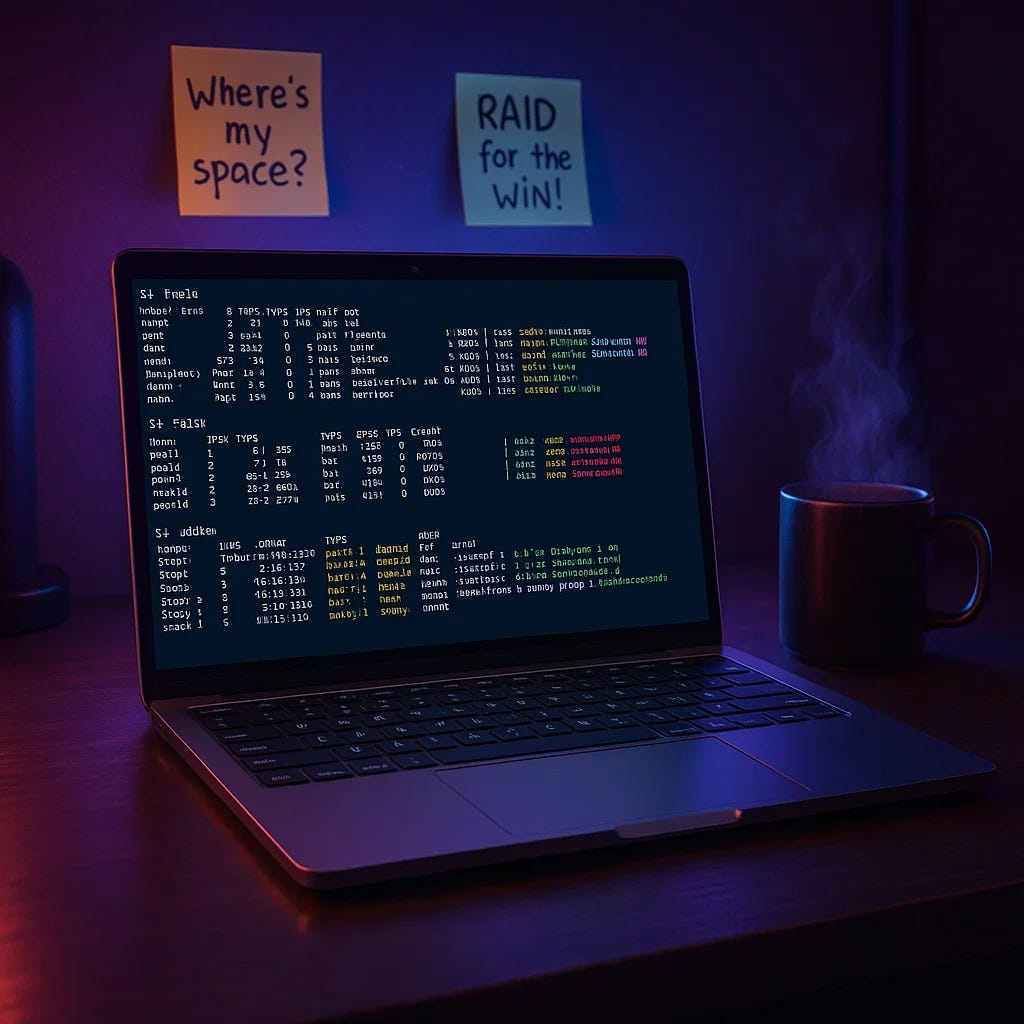Imagine you’re hosting a party. Your hard drive is the house, partitions are the rooms, and RAID is like building multiple identical houses in case one burns down. Now, if you don’t know what’s where, you’ll have people dancing in the bathroom while the living room is empty. Linux gives you the tools to not only check the floor plan but renovate, expand, and reinforce your house. And yes — sometimes it’s as dramatic as it sounds.
Why Should You Care?
Ever looked at your disk and thought, “Wait… wasn’t there more space yesterday?” Or maybe you’ve accidentally nuked the wrong partition (RIP, holiday photos). Storage management isn’t just for sysadmins in dark server rooms — it’s your map to avoid getting lost in the digital jungle.
Partition Information Commands — The “Where’s My Stuff?” Tools
lsblk — The Family Tree of Your Drives
This is your storage “X-ray.” It shows all connected drives and partitions in a neat tree structure. Add -f and you’ll also see filesystem type, labels, and UUIDs.
Example:
lsblk -fWhen to use: If you just plugged in a new SSD and want to check if it’s alive (and not an expensive paperweight).
blkid — Your Disk’s ID Card
Gives you UUIDs, filesystem types, and labels. Perfect for fstab entries or when your system refuses to boot and you’re hunting for that elusive root partition.
Example:
sudo blkidPartition Management Commands — Renovating Without Burning the House Down
fdisk & gdisk — The Old School Builders
fdisk is for MBR partitions, gdisk for GPT. It’s like knowing the difference between vinyl records and Spotify playlists—both store music, but differently.
Example:
sudo fdisk /dev/sdaThen follow the prompts: n for new, d for delete, p for print.
parted — The Big Disk Whisperer
Works with both MBR and GPT. Great for resizing without destroying data (aka “non-destructive resizing”).
Example:
sudo parted /dev/sdb mkpart primary ext4 1MiB 2GBgrowpart — The Cloud Expander
When your VM or cloud instance says “we’ve added more storage,” this is the tool to actually use it. Not similar to parted but just for increasing the existing disk space.
Example:
sudo growpart /dev/sda 1RAID — When One Disk is Never Enough
Why RAID Exists
Because disks fail. And when they do, they take your weekend with them. RAID lets you combine drives for speed (RAID 0), redundancy (RAID 1), or a mix (RAID 5/6).
mdadm — The RAID Boss
Create, manage, and monitor RAID arrays. We can use different options with mdadm like
- — manage to modify or update raid disks.
- — monitor to see health update of the disks
- — verbose for additional output.
The monitor option continuously looks out for the disks and incase of any failures it stops and starts a new one.
Example:
sudo mdadm --create --verbose /dev/md0 --level=1 --raid-devices=2 /dev/sdb /dev/sdcSave the config so it works after reboot:
sudo mdadm --detail --scan >> /etc/mdadm/mdadm.conf
sudo update-initramfs -uAlso I think learning about RAID is an interesting part, we will surely create a new article dedicated to this topic. Stay tuned for it.
/proc/mdstat — The Status Window
Instead of running multiple commands, peek here to see RAID level, sync progress, and any failures. So just looking into this file will give the system admins whats the raid configs, instead of remembering all complex commands.
Example:
cat /proc/mdstatTL;DR
lsblk/blkid— See what’s where.fdisk/gdisk/parted/growpart— Create, resize, or expand partitions.mdadm//proc/mdstat— Build and monitor RAID for speed or safety.
Knowing these commands saves you from “where did my files go?” panic mode.
“Remember — in Linux, your storage is like pizza: slice it how you like, share it if you must, and always keep a backup in case someone eats it all.”
Visit The Linux Walkthrough for more interesting and informative articles on linux.
